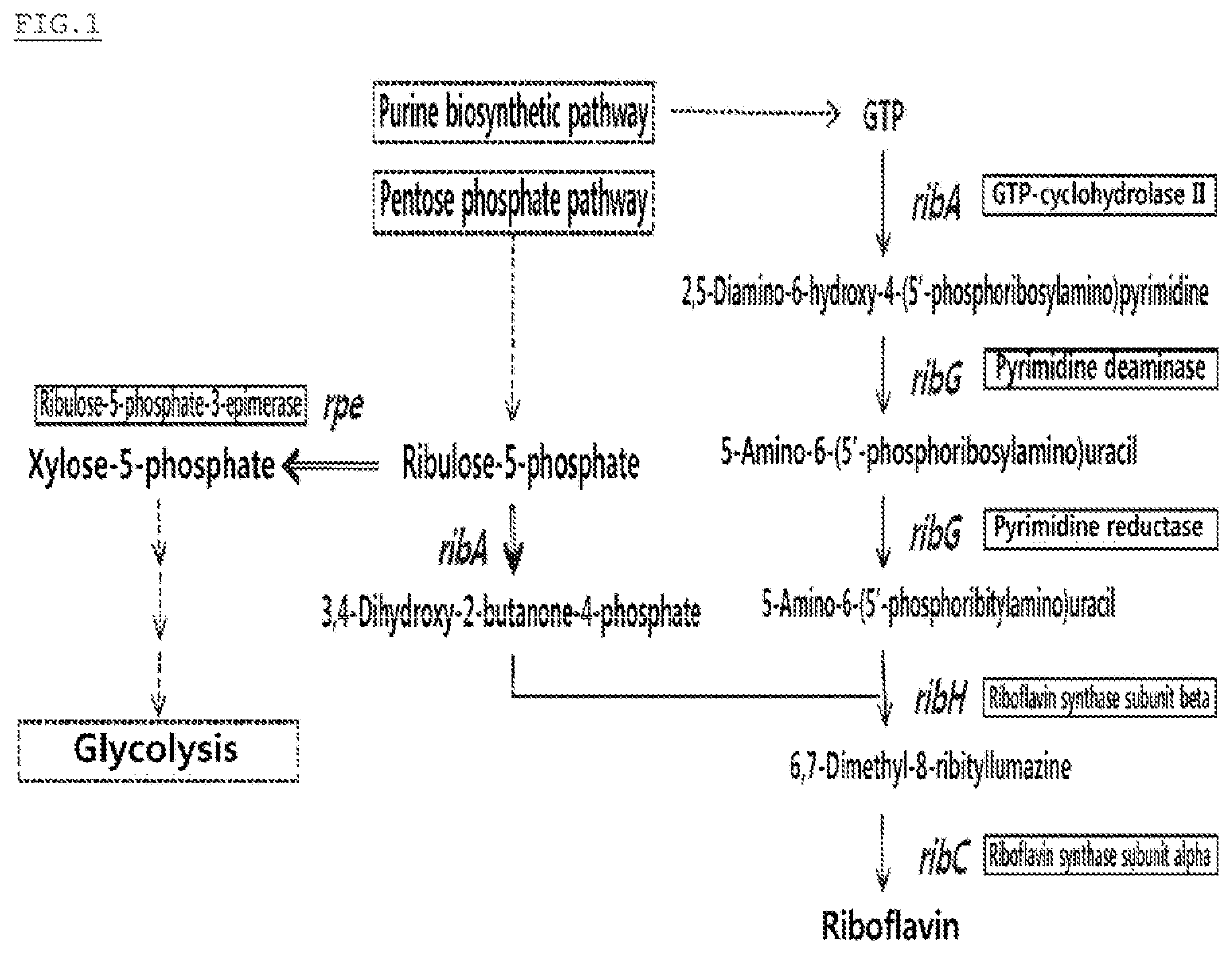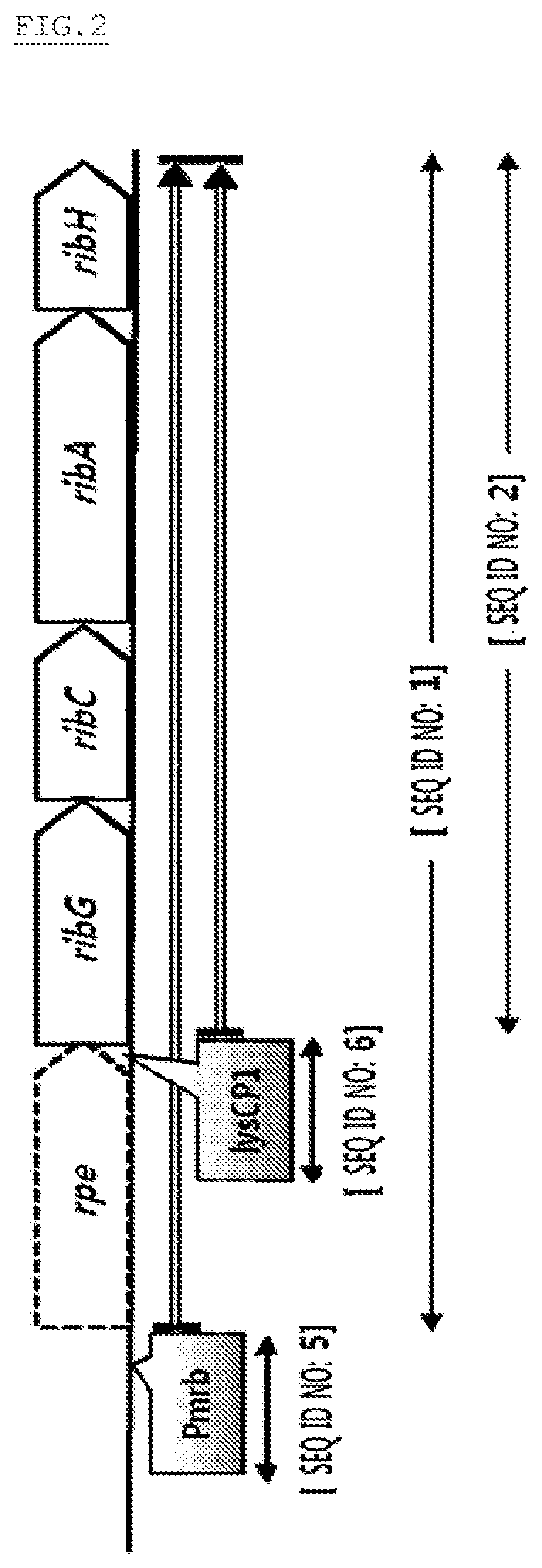Microorganism for simultaneously producing L-amino acid and riboflavin, and method for producing L-amino acid and riboflavin using same
a technology of riboflavin and l-amino acid, which is applied in the direction of microorganisms, biochemical equipment and processes, bacteria based processes, etc., can solve the problems of affecting the growth of embryos, deficiency of vitamin A, and death of embryos, so as to reduce production costs
- Summary
- Abstract
- Description
- Claims
- Application Information
AI Technical Summary
Benefits of technology
Problems solved by technology
Method used
Image
Examples
example 1
Screening of Gluconic Acid Tolerant Strain by Artificial Mutagenesis
[0081]In this Example, in order to increase carbon flow in the pentose-phosphate pathway that is the major source of nicotinamide adenine dinucleotide phosphate (NADPH) required for the production of L-amino acid, an experiment for imparting adaptability for high-concentration of gluconic acid to the Corynebacterium glutamicum strain was performed.
[0082]An artificial mutation in KFCC10881 (Korean Patent No. 0159812), as a parent strain, was induced by N-methyl-N-nitro-N-nitroguanidine (NTG) and then the strain was cultured in the following plate medium containing 20 g / l of gluconic acid while strains that formed colonies faster than a control group not treated with NTG were isolated. In the case of the control group, the average diameter of colonies formed at 60 hours was about 0.5 mm, whereas in the case of the NTG-treated group, a diameter of colonies reached 1 mm within 40 hours of culture. Among the colonies, a ...
example 2
Analysis of the Lysine-producing Ability of KFCC10881-YC and Examination of Cause of Color Development
[0085]In order to examine the characteristics of the KFCC10881-YC strain prepared in Example 1 above, the strain was cultured in the following manner to compare the Lysine-producing ability thereof, and the components of the culture medium were analyzed.
[0086]Specifically, each strain was inoculated into a 250-ml corner-baffle flask containing 25 ml of seed medium, and then cultured at 30° C. for 20 hours with shaking at 200 rpm. Next, 1 ml of the seed culture was inoculated into a 250-ml corner-baffle flask containing 24 ml of production medium and cultured at 30° C. for 72 hours with shaking at 200 rpm. The compositions of the seed medium and the production medium are as follows.
[0087]Composition of Seed Medium (pH 7.0)
[0088]20 g glucose, 10 g peptone, 5 g yeast extract, 1.5 g urea, 4 g KH2PO4, 8 g K2HPO4, 0.5 g MgSO4 7H2O, 100 μg biotin, 1000 μg thiamine HCl, 2000 μg calcium-pant...
example 3
Examination of Modification in Promoter Upstream of Rib Operon of Strain Producing High Concentration of Riboflavin, and Construction of a Vector for Chromosomal Integration of the Modified Promoter (Pmrb)
[0094]In order to investigate the nucleotide mutation that induced the color change and increased the riboflavin producing ability in the KFCC10881-YC strain prepared in Example 1, nucleotide sequence of the chromosomal region related to the riboflavin biosynthesis in the Corynebacterium glutamicum sp. KFCC10881-YC strain was determined and confirmed based on the NIH GenBank database.
[0095]As a result, it was found that −10th and −16th nucleotide residues from the initiation codon of the rpe gene located upstream of the rib operon had a G-to-A substitution and a G-to-T substitution, respectively. The promoter having the two nucleotide substitution in the expected region of the rib operon promoter was named “Pmrb” (SEQ ID NO: 5).
[0096]In order to examine the effect of increase in ri...
PUM
| Property | Measurement | Unit |
|---|---|---|
| temperature | aaaaa | aaaaa |
| temperature | aaaaa | aaaaa |
| size | aaaaa | aaaaa |
Abstract
Description
Claims
Application Information
 Login to View More
Login to View More - R&D
- Intellectual Property
- Life Sciences
- Materials
- Tech Scout
- Unparalleled Data Quality
- Higher Quality Content
- 60% Fewer Hallucinations
Browse by: Latest US Patents, China's latest patents, Technical Efficacy Thesaurus, Application Domain, Technology Topic, Popular Technical Reports.
© 2025 PatSnap. All rights reserved.Legal|Privacy policy|Modern Slavery Act Transparency Statement|Sitemap|About US| Contact US: help@patsnap.com



